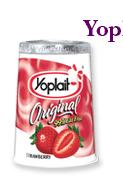
Faire original et naturel, pour l'industrie agro-alimentaire, cela devient très compliqué.
Preuve en est avec l'exemple d'un simple yaourt, à condition qu'on sache décrypter ce qui se cache derrière les termes techniques des informations nutritionnelles.
Le yaourt en question est donc, pour ne pas le nommer, un Yoplait Original saveur fraise, vendu aux USA.
Voici donc la présentation officielle du produit: "All the health and goodness of yogurt with the delicious blended creaminess of Yoplait®" On se lèche les babines...
Voici ensuite les informations fournies sur le packaging: Yoplait Strawberry Contains: cultured pasteurized grade A low fat milk, sugar, strawberries, modified corn starch, high fructose corn syrup, nonfat milk, kosher gelatin, citric acid, tricalcium phosphate, natural flavor, pectin, colored with carmines, vitamin A acetate, vitamin D3.
Et voici, grâce à la curiosité d'une blogueuse, ce qui cache comme processus de fabrication derrière ces termes quelques peu barbares, comme cultured pasteurized grade A low fat milk...
- cultured pasteurized grade A low fat milk: It’s cultured, which means bacteria has been added to it to ferment the lactose and galactose (milk sugars) and convert them into lactic acid. Milk is fermented in order to increase the shelf-life, add taste, and increase digestibility. It’s pasteurized, which means it’s been heated to destroy some viable pathogens. It’s Grade A, meaning it complies with the National Conference on Interstate Milk Shipments “Grade A” milk program, which is based on the FDA’s Pasteurized Milk Ordinance requirements to be shipped interstate. It’s low fat which mean it’s gone through a centrifuge which separates the fat from the the rest of the product.
- sugar: This either comes from the sugarcane or the sugar beet.
- strawberries: Strawberries.
- modified corn starch: This is made by removing the starch from the corn through a fermentation process and a centrifuge. The starch is dried and modified, typically with inorganic acids, to become a fat substitute and to act as a thickener for the yogurt.
- high fructose corn syrup: High fructose corn syrup is a sweetener that’s included in many foods. In fact, it’s in most processed foods that you eat. HFCS extends the shelf-life of food and is a cheaper sweetener than sugar. It’s made by turning the sugar that’s in cornstarch into fructose.
I recently saw the documentary King Corn, where the filmmakers asked the syrup makers in the Corn Belt if they could film the HFCS making process. There are about 16 chemical plants that produce the syrup and none allowed it! So the filmmakers dug up a recipe and made it themselves. It was disturbing – a vat of murky fermented liquid with much chemical tweaking. Although there are not conclusive human studies that indicate HFCS has detrimental health effects, there are animal studies that link HFCS with diabetes and high cholesterol. HFCS can also leave you hungry or make you eat more. Consuming HFCS raises your insulin and blood sugar levels less than does consuming glucose (regular sugar). Thus, your body does not think it’s as full as it does when you consume calories from other foods. Thus, you eat more.
- nonfat milk: Same as low fat milk, just with less fat.
- kosher gelatin: Gelatin. That’s horse byproduct! It’s made from the prolonged boiling of animal skin, tissue, and bones. But it’s kosher, meaning, well, it’s still made form fish bones and beef skins.
- citric acid: This is an organic acid that exists in citrus fruits and is a natural preservative and flavor additive.
- tricalcium phosphate: It’s a calcium salt. I’ve read that it is added to reduced fat foods to develop smoothness and opaqueness, as well as increase calcium content.
- natural flavor: A bit nebulous, right? But if you recall from Fast Food Nation, natural flavor isn’t natural at all - it’s an additive concocted by flavorists. The exact definition of natural flavor from the Code of Federal Regulation is “the essential oil, oleoresin, essence or extractive, protein hydrolysate, distillate, or any product of roasting, heating or enzymolysis, which contains the flavoring constituents derived from a spice, fruit or fruit juice, vegetable or vegetable juice, edible yeast, herb, bark, bud, root, leaf or similar plant material, meat, seafood, poultry, eggs, dairy products, or fermentation products thereof, whose significant function in food is flavoring rather than nutritional.”
- pectin: Pectin is a gelling agent much like gelatin. Except pectin is derived from the cell walls of plants instead of cows or fish bones.
- colored with carmines: That’s Red No. 40, made of carminic acid, which is produced by the cochineal insect. Yes, that’s right. Small red bugs make my yogurt pink.
- vitamin A acetate: This is a one of the primary forms of Vitamin A nutritional supplement
- vitamin D3: It’s the same vitamin your skin gets when exposed to the sun.
Conclusion de la blogueuse: "Needless to say, I gave up Yoplait long ago. I’ve switched to organic, in which gelatin is replaced with pectin, there are no fake colors, high fructose corn syrup is replaced with actual sugar, and there is no acid modified corn starch. It’s delicious and has just a small price premium over Yoplait or Dannon.

